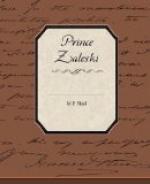I handed the volume to Zaleski. He pointed to a passage which read as follows:
’Assuredly the turquoise doth possess a soul more intelligent than that of man. But we cannot be wholly sure of the presence of Angels in precious stones. I do rather opine that the evil spirit doth take up his abode therein, transforming himself into an angel of light, to the end that we put our trust not in God, but in the precious stone; and thus, perhaps, doth he deceive our spirits by the turquoise: for the turquoise is of two sorts: those which keep their colour, and those which lose it.’[1]
[Footnote 1: ’Assurement la turquoise a une ame plus intelligente que l’ame de l’homme. Mais nous ne pouvons rien establir de certain touchant la presence des Anges dans les pierres precieuses. Mon jugement seroit plustot que le mauvais esprit, qui se transforme en Ange de lumiere se loge dans les pierres precieuses, a fin que l’on ne recoure pas a Dieu, mais que l’on repose sa creance dans la pierre precieuse; ainsi, peut-etre, il decoit nos esprits par la turquoise: car la turquoise est de deux sortes, les unes qui conservent leur couleur et les autres qui la perdent.’ Anselm de Boot, Book II.]
‘You thus see,’ resumed Zaleski, ’that the turquoise was believed to have the property of changing its colour—a change which was universally supposed to indicate the fading away and death of its owner. The good De Boot, alas, believed this to be a property of too many other stones beside, like the Hebrews in respect of their urim and thummim; but in the case of the turquoise, at least, it is a well-authenticated natural phenomenon, and I have myself seen such a specimen. In some cases the change is a gradual process; in others it may occur suddenly within an hour, especially when the gem, long kept in the dark, is exposed to brilliant sunshine. I should say, however, that in this metamorphosis there is always an intermediate stage: the stone first changes from blue to a pale colour spotted with brown, and, lastly, to a pure white. Thus, Ul-Jabal having stolen the stone, finds that it is of the wrong colour, and soon after replaces it; he supposes that in the darkness he has selected the wrong chalice, and so takes the valueless stone from the other. This, too, he replaces, and, infinitely puzzled, makes yet another hopeless trial of the Edmundsbury chalice, and, again baffled, again replaces it, concluding now that the baronet has suspected his designs, and substituted a false stone for the real one. But after this last replacement, the stone assumes its final hue of white, and thus the baronet is led to think that two stones have been substituted by Ul-Jabal for his own invaluable gem. All this while the gem was lying serenely in its place in the chalice. And thus it came to pass that in the Manor-house of Saul there arose a somewhat considerable Ado about Nothing.’
For a moment Zaleski paused; then, turning round and laying his hand on the brown forehead of the mummy by his side, he said:




